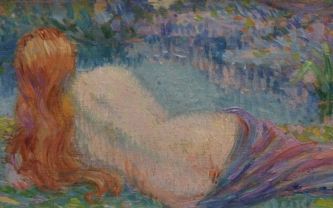Kazuo Shiraga, the value of his surprising works

If you own a work of art by or after Kazuo Shiraga, and would like to know its value, our state-approved experts and auctioneers will offer you their appraisal services. Our specialists will carry out a free appraisal of your work, and provide you with a precise estimate of its current market value. Then, if you wish to sell your work, we'll guide you towards the best possible arrangement to obtain the optimum price.
Rating and value of works by Kazuo Shiraga
A performative painter, Kazuo Shiraga is a Japanese artist best known for his participation in the avant-garde Gutai art movement. He produced paintings, watercolor drawings, prints and sculptures, of which we have few examples. Prices for his works range from €100 to €7,600,000. In 2014, an abstract painting entitled "Kaien", upholstered in blue cameos and enhanced by a few red touches, sold for €2,068,000.
Order of value from a simple work to the most prestigious
Estimate | |
Paint | 617 - 7 600 000€ |
Drawing - Watercolor | 223 - 240 000€ |
86 - 22 080€ | |
Response in less than 24h
Kazuo Shiraga's style and technique
To bring his abstract paintings to life, Shiraga flies over the canvas, his feet coated with paint, swinging back and forth and smearing the canvas with his footprints. While he admires the aesthetic rendering of Jackson Pollock's dripping, Shiraga gives texture and depth to his splashes and swirls. In this way, he explores the relationship between the body and paint.

"The Japanese who painted with his feet
Kazuo Shiraga was born in Amagasaki in 1924. Under the guidance of his father, he developed a passion for painting from an early age. He began training as a painter at the age of thirteen and discovered an encouraging talent. However, in 1944, Shiraga was forced to abandon his brushes to go and fight the Allies in the Second World War to serve his native country. The climax of the war in Japan came when the country was put to the sword by the explosion of atomic bombs on Hiroshima and Nagasaki in August 1945.
In the aftermath of the earthquake, Shiraga continued his artistic studies at the Kyoto Professional Painting School and returned safely to his canvases. In a mourning Japan trying to rebuild, Shiraga escaped death from severe pneumonia. In 1952, he founded the Zero-Kai movement with his friends Saburô Murakami, Akira Kanayama and Atsuko Tanaka.
These four artists display a libertarian style that defies convention, moving towards an ever more corporeal and conceptual style of painting.
How Shiraga marked his era
Originally, Shiraga painted with a palette knife, then moved on to using his fingernails, and finally found his singular style by painting canvases with his feet.
In 1955, the Zero-Kai movement took the name "Gutai", a term derived from the Japanese "gutaiteki", which can be translated as "concrete". This paradigm shift can be seen as a refusal to be affiliated with abstract art. While Shiraga paints with his own body, we now know where the Cohen brothers got their inspiration for the Maude Lebowski character. Shiraga was spotted by French critic Michel Tapié during an exhibition, who suggested he join the movement to which he belonged, Art Informel. This meeting between the two artists, each leading the artistic movement to which they belonged, was to prove decisive in the spread and renown of Gutaï on the international art scene.
He also organizes jousts in the mud, always with the aim of marking his supports with his bodily imprints. What counts for Shiraga is less the final result of the work than the path and process of creation, the essence of his art, which becomes a form of catharsis. In 1971, Shiraga withdrew to a Buddhist monastery, which had a profound influence on his painting, tinting it with a resolutely spiritual tone. He retains his unique technique of painting with his feet, but no longer takes to the stage, abandoning the performance and public scene that characterized Gutai. He now paints at home, with his wife.
How to recognize Kazuo Shiraga's signature
Shiraga usually signs his paintings in the bottom right-hand corner, sometimes in Japanese, sometimes in Western characters, and sometimes in both.

How to know the value of a work by Kazuo Shiraga
If you happen to own a work by Kazuo Shiraga, don't hesitate to request a free appraisal using the form on our website. A member of auctie's will contact you promptly to provide you with an estimate of the value of your work, as well as ad hoc information about it. If you're thinking of selling your work, our specialists will also help you find alternative ways of selling it at the best possible price.
Response in less than 24h
Related topics

Rating and value of Jean Prouvé furniture, chairs and desks
Jean Prouvé is a 20th-century ironmonger and designer, who produced a great deal of furniture that is highly valued at auction.
Read more >

Rating and value of Yves Saint Laurent's fashion drawings
Yves Saint Laurent is a great twentieth-century couturier who produced many valuable fashion designs throughout his career.
Read more >

Rating and value of paintings by Hippolyte...
Hippolyte Petitjean is a twentieth-century pointillist painter who produced numerous works of high value.
Read more >
Secure site, anonymity preserved
State-approved auctioneer and expert
Free, certified estimates